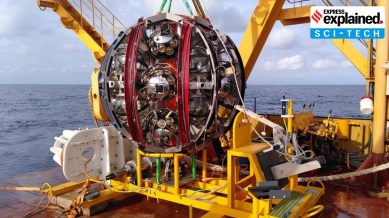Why scientists are installing underwater telescopes to detect ‘ghost particles’
These telescopes are much like the IceCube Neutrino Observatory, which can detect high-energy neutrinos from deep space but is under the frozen ice in the Antarctic rather than being in the water

Scientists are deploying two telescopes to detect high-energy neutrinos, also known as ghost particles, under the Mediterranean Sea. The two telescopes are part of the Cubic Kilometre Neutrino Telescope or KM3NeT. While one of the telescopes will study high-energy neutrinos from space, the other will examine neutrinos from the atmosphere.
These telescopes are much like the IceCube Neutrino Observatory, which can detect high-energy neutrinos from deep space but is under the frozen ice in the Antarctic rather than being in the water.
Here is a look at what neutrinos are, why scientists want to study high-energy neutrinos, and why the neutrino telescopes have been placed deep under the sea.
What are neutrinos?
Detected for the first time in 1959 — though their existence was predicted almost three decades earlier, in 1931 — neutrinos are tiny particles, very similar to electrons, but without any electric charge. They are one of the fundamental particles the universe is built of, and are the second most abundant subatomic particles after photons. Neutrinos are so numerous that about a billion of them pass through a cubic centimetre of space every second.
Why do scientists want to study high-energy neutrinos?
Although neutrinos are everywhere, not each one of them is important to study. Scientists are interested in examining super-fast, high-energy neutrinos that have come from far, far away. Such neutrinos are rare and mostly originate from exotic events such as supernovae, gamma-ray bursts or colliding stars.
Studying high-energy neutrinos can help astrophysicists investigate those space mechanisms and regions like the centre of our Milky Way Galaxy which are shrouded in dust. Dust absorbs and scatters the visible light from objects, making them difficult or impossible to observe with optical telescopes.
In a 2022 interview with Cosmos magazine, Elisa Resconi, an astrophysicist at the Technical University of Munich, Germany, said, “With neutrinos… we can study beyond any dense cloud or accretion disk.”
Not only this, high-energy neutrinos can also give clues about cosmic ray production or even dark matter.
“And of course, we could also discover something we cannot imagine today… We understand only a very small fraction of the universe.”
So why are scientists building underwater neutrino telescopes?
High-energy neutrinos, however, are not just rare but also extremely difficult to detect. One reason is that neutrinos barely interact with anything — despite billions of neutrinos around us, an average of only about one of them will interact with a person’s body during a lifetime.
Even the IceCube, which has been operational since 2011 and was the first telescope to detect high-energy neutrinos, has been able to only spot a handful of these messengers.
To detect high-energy neutrinos, there is a need for a large volume of optically transparent material in a place where it is extremely dark. “The location needs to be dark because the detectors look for flashes of Cherenkov radiation: light that neutrinos produce when they interact with a water or ice molecule,” according to a report by Cosmos magazine.
These flashes help scientists trace the path of that neutrino, giving them details about its source, the amount of energy it contains, and its origins.
Although both frozen ice and deep sea waters provide conducive conditions for detecting high-energy neutrinos, experts suggest that underwater neutrino telescopes could be more efficient than IceCube.
That is because water scatters light less, which gives a more accurate idea about where the detected neutrinos came from. The one disadvantage is that water absorbs light more and as a result, there will be less light to examine.